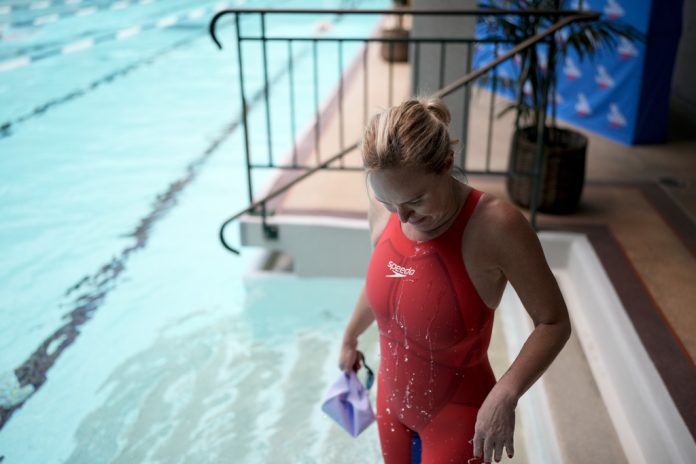PARIS (AP) — It’s usually not a good sign when a swimsuit needs instructions for how to put it on. More concerning? When you learn that even Olympians need about 10 minutes to get into Speedo’s new Fastskin LZR Intent and LZR Valor suits.
Determined to squeeze into the latest skin-tight polyurethane compression suit, I grabbed a red Pure Valor 2.0 openback kneeskin and entered the crowded women’s changing room at The Molitor Hotel to see what the big deal is about the newest version of the suit many swimmers will be wearing during the Paris Olympics.
Wedged inside the changing room, I followed the directions and rolled up the leg openings to work around the rubber gripper at the bottom that is designed to help the suit stick to your skin. Those who didn’t listen to the instructions were grunting, tugging and wiggling as they tried to shimmy the suit now stuck to their calves.
I was ahead of them all and had the suit to my thighs! The race was on!
And then the trouble began.
I pulled and the suit moved less than an inch. I pulled some more and same result. Not a chance this thing was making it over my hips.
The Fastskin isn’t like a regular one-piece bathing suit. It looks more like a singlet worn by a wrestler and is meant to sit above the knee and worn like a one-piece romper. A very, very, tight romper.
Introduced earlier this year and developed by Speedo’s Aqualab research and development facility, the Fastskin is engineered from Lamoral Space Tech material that is used on satellites. High-level competition suits have been improving for years, and this version is more aerodynamic and repels water to help swimmers stay buoyant.
I was getting into this thing — the most expensive swimsuit I’ve ever worn, at about $550 — no matter what. But now I was sweating — really sweating — as I tried every dressing room hack ever learned.
“It’s too tight,” said one woman.
“They gave me the wrong size,” grumbled another.
No, all the suits were sized correctly. They just really are that difficult to put on. I finally figured out my best approach was to take the suit inch by inch, pulling up any bunched material gained with every tug. I foolishly neglected to set a timer, but it’s fair to say it took me more than 10 minutes to get into the suit.
Even so, I felt like a gold medalist when I finally finished the task — a full workout in itself. Drenched in sweat, I headed to the Molitor’s indoor pool, which is considered one of Paris’ most popular swimming baths and opened in 1929.
I was eager to get into the water but was stopped by Kate Wilton, Aqualab’s senior director of competitive product. She wanted me to note the wicking ability of the suit, and sure enough, as I splashed water on myself, it dribbled down the suit in small droplets. Speedo says the 2.0 version of the suit has the lowest water absorption and is the most water repellent of any of its previous products.
It was finally time to swim.
Led by Cullen Jones, the first Black swimmer to hold a world record, we were instructed to “streamline” off the wall and see how far we could travel under water with our arms crossed above our heads and without kicking. It’s been a solid two decades since I’ve done any “real” swimming, but in this suit, I covered some decent distance in coming up about the halfway point of the Molitor’s 33-meter pool.
Next it was time to test the buoyancy, which I did by floating on my back. This suit was like a life preserver in that I could float without moving a muscle and stay nearly on top of the water.
That’s one of the main benefits of the suit — the fabric zone on the rear targets drag reduction, making swimmers feel like they are on top of the water. I felt it immediately when I actually started swimming. I didn’t have to think about form or wonder if my torso was dipping lower in the water than my head and arms. I felt perfectly aligned as I swam several laps of freestyle.
Some 80 world records have been set since the first version of these suits were introduced at the 2000 Sydney Olympics, where 83% of medals were won by swimmers wearing it. Michael Phelps won eight gold medals wearing the LZR Racer at the Beijing Olympics.
Did the suit make me any faster? While Olympians believe it does, I can’t be sure because I haven’t swam competitively in years, but after slowly wedging myself into it, the suit had me comfortable, floating above the water and believing I could take on Katie Ledecky.
Source: post





